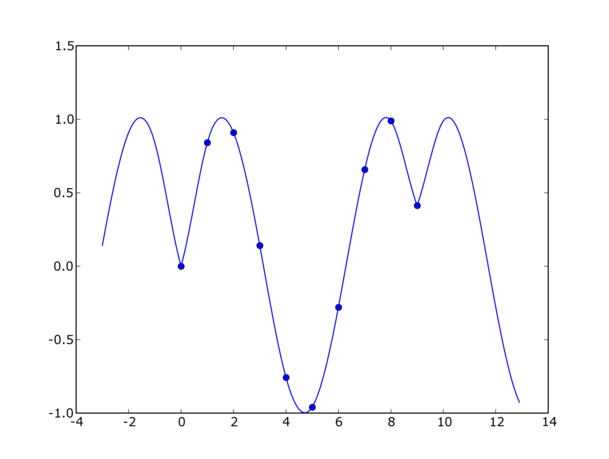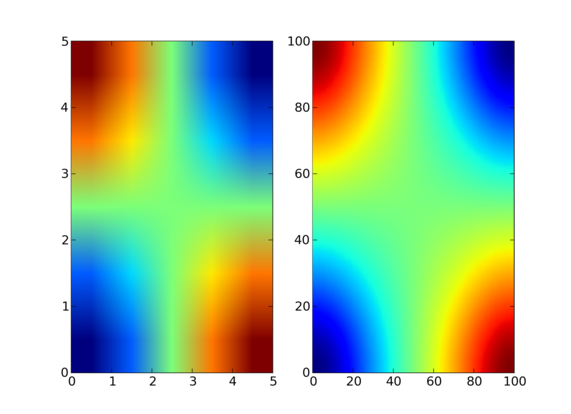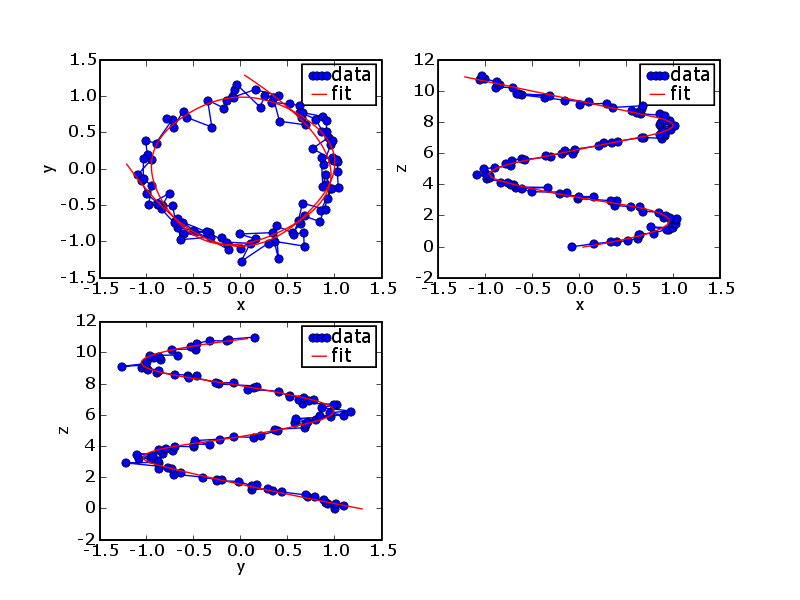Contents
Using B-splines in scipy.signal
Example showing how to use B-splines in scipy.signal to do interpolation. The input points must be equally spaced to use these routine.
from numpy import r_, sin
from scipy.signal import cspline1d, cspline1d_eval
x = r_[0:10]
dx = x[1]-x[0]
newx = r_[-3:13:0.1] # notice outside the original domain
y = sin(x)
cj = cspline1d(y)
newy = cspline1d_eval(cj, newx, dx=dx,x0=x[0])
from pylab import plot, show
plot(newx, newy, x, y, 'o')
show()

N-D interpolation for equally-spaced data
The scipy.ndimage package also contains spline_filter and map_coordinates which can be used to perform N-dimensional interpolation for equally-spaced data. A two-dimensional example is given below:
from scipy import ogrid, sin, mgrid, ndimage, array
x,y = ogrid[-1:1:5j,-1:1:5j]
fvals = sin(x)*sin(y)
newx,newy = mgrid[-1:1:100j,-1:1:100j]
x0 = x[0,0]
y0 = y[0,0]
dx = x[1,0] - x0
dy = y[0,1] - y0
ivals = (newx - x0)/dx
jvals = (newy - y0)/dy
coords = array([ivals, jvals])
newf = ndimage.map_coordinates(fvals, coords)
To pre-compute the weights (for multiple interpolation results), you would use
coeffs = ndimage.spline_filter(fvals)
newf = ndimage.map_coordinates(coeffs, coords, prefilter=False)

Interpolation of an N-D curve
The scipy.interpolate packages wraps the netlib FITPACK routines (Dierckx) for calculating smoothing splines for various kinds of data and geometries. Although the data is evenly spaced in this example, it need not be so to use this routine.
from numpy import arange, cos, linspace, pi, sin, random
from scipy.interpolate import splprep, splev
# make ascending spiral in 3-space
t=linspace(0,1.75*2*pi,100)
x = sin(t)
y = cos(t)
z = t
# add noise
x+= random.normal(scale=0.1, size=x.shape)
y+= random.normal(scale=0.1, size=y.shape)
z+= random.normal(scale=0.1, size=z.shape)
# spline parameters
s=3.0 # smoothness parameter
k=2 # spline order
nest=-1 # estimate of number of knots needed (-1 = maximal)
# find the knot points
tckp,u = splprep([x,y,z],s=s,k=k,nest=-1)
# evaluate spline, including interpolated points
xnew,ynew,znew = splev(linspace(0,1,400),tckp)
import pylab
pylab.subplot(2,2,1)
data,=pylab.plot(x,y,'bo-',label='data')
fit,=pylab.plot(xnew,ynew,'r-',label='fit')
pylab.legend()
pylab.xlabel('x')
pylab.ylabel('y')
pylab.subplot(2,2,2)
data,=pylab.plot(x,z,'bo-',label='data')
fit,=pylab.plot(xnew,znew,'r-',label='fit')
pylab.legend()
pylab.xlabel('x')
pylab.ylabel('z')
pylab.subplot(2,2,3)
data,=pylab.plot(y,z,'bo-',label='data')
fit,=pylab.plot(ynew,znew,'r-',label='fit')
pylab.legend()
pylab.xlabel('y')
pylab.ylabel('z')
pylab.savefig('splprep_demo.png')
